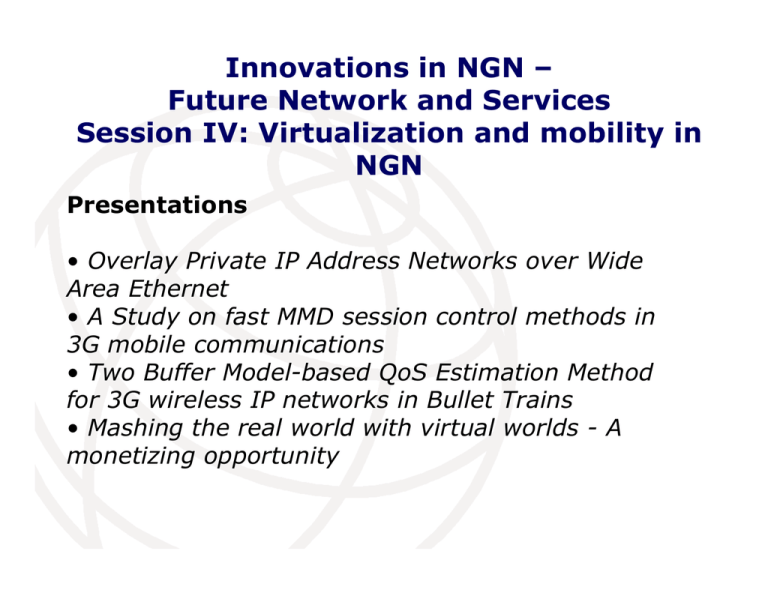Innovations in NGN – Future Network and Services NGN
advertisement

Innovations in NGN – Future Network and Services Session IV: Virtualization and mobility in NGN Presentations • Overlay Private IP Address Networks over Wide Area Ethernet • A Study on fast MMD session control methods in 3G mobile communications • Two Buffer Model-based QoS Estimation Method for 3G wireless IP networks in Bullet Trains • Mashing the real world with virtual worlds - A monetizing opportunity International Telecommunication Union Virtualization: Overlay Private IP Address Networks over Wide Area Ethernet • Research purpose: New remote access methods for Overlay private IP address networks over Wide area Ethernet to achieve better security and lower management cost than legacy PPP+VPN method • Proposal: two solutions are proposed made based on FA-mode MIP (MIPv4): MIP+PPPoE , MIP+VLAN • MIP+VLAN has more advantages: low implementation cost (no new protocol for MN), lower access delay • Future work • Layer 2 encryption and wireless security • Scalability for Wide area Ethernet service supporting device mobility (testbed) • Discussion on scalability issues (VLAN mapping cost) International Telecommunication Union Mobility: A study on fast MMD session control methods in 3G mobile communications • Multimedia service session control in IMS/MMD: • Session Management (SIP) – call control • Mobility Management (MIP) – MN reachability • IMS/MMD issues: fast session control required, redundancy of MIP and SIP independent registration and authentication • Proposal: collaborative methods between SIP and MIP (four methods proposed) achieving control traffic reduction • Experimental measurements (Integrated method is the best) • registration time reduced (more than expected) • re-connection time still high (7s) - methods are not applied to other processes (processing, radio link changing time) • Future work: application of fast methods to other processes • Discussion on values used for backbone and access network International Telecommunication delays Union Mobility: Two Buffer Model-based QoS Estimation Method for 3G wireless IP networks in Bullet Trains • Research purpose: To improve transport layer protocols over 3G wireless IP networks in high-speed mobile environment • Idea: introduction of route characteristics in QoS metrics for communication quality • Communication environment modelling on simulator • Usage of two buffer model-based QoS estimation method • Measurement of communication quality and raw packet transmission characteristics of CDMA2000 1xEV-DO • Tokaido Shinkansen route experiment: measures of RTT (Probing CE, Echo CE), Packet Loss Ratio, Probing CE Status • Future work • Statistical estimation of throughput • Usage of various parameters for modelling of communication environment on simulator International Telecommunication Union Virtualization: Mashing the real world with virtual worlds - A monetizing opportunity • Social networks (SN) and Virtual Worlds (VW) are about communication among members and avatars • Multi-modal communication • Communication not entirely using traditional telecom networks (SN/VW providers provide communication facilities inside their applications) • Cross border communication is not yet possible • Open standards are key to interconnect, but: • Each SN/VW provider currently provides its own APIs to facilitate communication between the SN/VW and the real world • Telecom operators are essentially communication providers • Business opportunities for Telecom operators in this emerging space • They may be the instance to interconnect SN/VW • They may provide identity mapping (keeping anonymity if required) • They may augment SN/VW capabilities with their own telecom enablers (Presence/Location, Customers’ phone book, …) • Multiple business scenarios International Telecommunication • Operators may force open standards for inter SN/VW communication Union Some standardization opportunities (1) • Wide Area Ethernet: today’s technology for NGN transport • Optimized VPN solutions over Wide Area Ethernet are for today => proposals for discussion in appropriate SDOs (IEEE, ongoing cooperation with ITU-T on Wide Area Ethernet) • Seamless service mobility: key objective in NGN & beyond • Fast IMS/MMD session control methods: considerations similar to above apply in the mediumterm (3GPP/3GPP2, IETF, (ITU-T)) International Telecommunication Union Some standardization opportunities (2) •Emerging high-speed mobile environments: enhancing transport protocols to meet application requirements • Comprehensive environment modelling is necessary • Academic studies and experiments are advancing the understanding of these emerging environments •Requirements and solutions could be moved within standardisation in the medium-term (IETF, ISO, ITU-T) • Social Networks and Virtual Worlds: popular applications, but still requiring interoperability and linkage with telecom world • SN/VW standardised APIs to communicate with real world • Full communication-enabled SN/VW applications • Open standards for inter SN/VW communications • Integration and harmonization of SN/VW APIs standardisation within global, cross-SDO standardisation effort on SOA for IT-Telecom convergence (OMA, Parlay, OASIS, ITU-T) • Standardisation could start asap with requirementsInternational Telecommunication Union • Involvement of social actors and users


